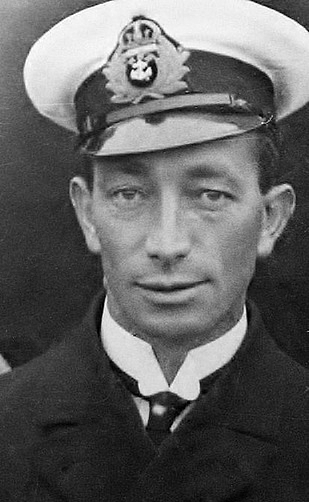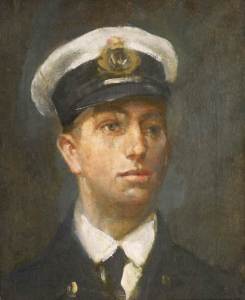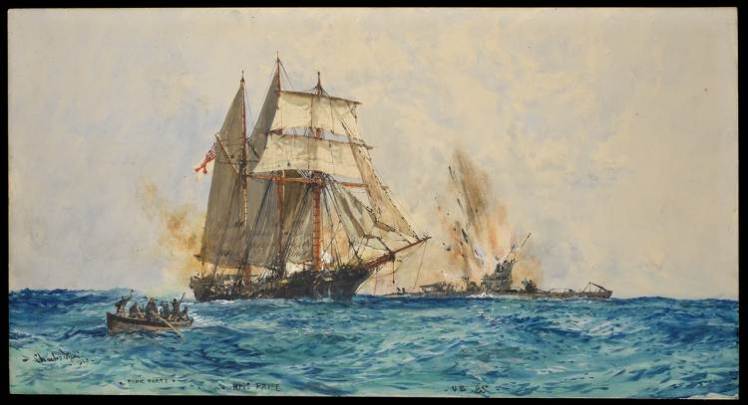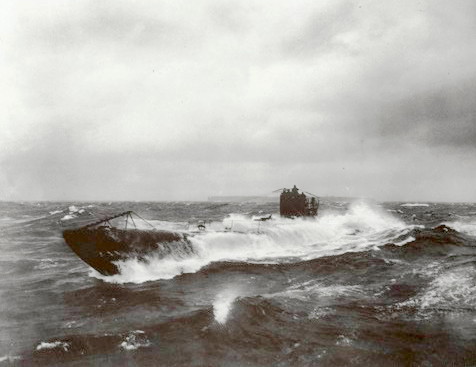The story of William Sanders (1883-1917) remains one of the most intriguing personal sea experiences of the First World War. His career, though brief, can best be described as outstanding: in quick succession he won first the Victoria Cross and then the Distinguished Service Order. He quickly established himself as the Q-ship hero of the First World War.
Lieutenant William Edward Sanders, VC, DSO, RNR. Oil by Arthur Ambrose McEvoy, National Maritime Museum, http://collections.rmg.co.uk/collections/objects/14618.html
None of this was expected. Sanders came from Auckland, New Zealand. He had made the sea his career afloat, starting as a ship’s boy, and working up the line to get his Extra Master’s ticket.[1] He was usually known as ‘Billy’, a name that became ‘Gunner Billy before the end. By 1915 he was third mate on the troop ship Tofua, but resigned his position to join the Royal Naval Reserve,[2] making his way to Britain aboard the steamer Hepburn Jan.[3] In April 1916 he was appointed temporary Sub-Lieutenant.
Submarine use against maritime targets was guided by international law. At the time, a warship commander intending to destroy a civilian vessel was required to approach under flag and order the target to surrender. Only if they did not – or fought back – could the commander then open fire. This applied to submarines and eliminated the main stealth advantage. It was possible to disregard the law, although Germany’s early effort to wage ‘unrestricted’ submarine warfare in 1915 ended in diplomatic disaster when the Lusitania went down with US citizens aboard. However, even when unrestricted warfare was renewed in early 1917, many commanders attacked from the surface in any case because their supply of torpedoes was limited and most U-boats had a deck-gun.
That opened up ways for the British to counter the threat. At the time, there was no way of detecting a submarine underwater – eagle-eyed crew had to watch for a periscope. But a surfaced U-boat was a different matter. The problem was that no U-boat commander would try to engage a warship that way, and from this emerged the concept of the ‘Q-ship’ – an innocent looking merchant, often a sailing ship, fitted with collapsible deck-houses and other devices to hide a significant armament. Many were also loaded with a cargo of wood, largely to help keep them afloat if torpedoed. Tactics included having a ‘panic party’ ready to ‘abandon ship’ as soon as a U-boat appeared, lulling the German vessel within range of the guns.
Service on the Q-ships was dangerous; they had no protection against gunfire, nor any underwater defences, and needed to fight from close range. Many were early war prizes themselves. Sanders first served as First Lieutenant and Gunnery Officer on board just such a vessel, the Q-ship Brig-10, also known as the Heligoland. Then in February 1917, promoted to Lieutenant, Sanders took command of the 277-ton, steel hull topsail schooner HMS First Prize, the former German Else, built in 1901 and captured just hours after outbreak of war in 1914.[4] She had been refitted with a powerful armament for her size; two 12-pounders, a Lewis gun and a Maxim gun,[5] though this is often mis-stated in some references, as is her British service name, First Prize, which was not changed until after her first action.
By this time the Germans had returned to unrestricted submarine warfare. Sanders formally commissioned the ship on Anzac Day 1917, then sailed for the Western Approaches, the waters south of Ireland where U-boats often lurked. It did not take long for them to find one: U-93, under Kapitanleutnant Edgar von Spiegel von und zu Peckelsheim (1885-1965). He was a member of the nobility, a best-selling author – and a crack U-boat commander. When Sanders found him, von Spiegel was returning from a patrol during which he had sunk ten vessels, including the 4,889 ton steamer Comedian.[6]
HMS First Prize in action with U-93, the ‘panic party’ on the left. Watercolour by Charles Edward Dixon, National Maritime Museum, PAJ3082, http://collections.rmg.co.uk/collections/objects/460852.html
The U-boat was the first of a new class displacing some 838 tons on the surface, with a surface speed of nearly 17 knots, a crew of 39, and – along with 16 torpedoes – a 10.5 cm (4.1-inch) deck gun.[7] However, von Spiegel had just two torpedoes left and elected to sink the apparently defenceless sailing ship using his deck gun.[8] Sanders despatched the ‘panic party’, but then von Spiegel opened fire on the ship in a devastating 20-minute bombardment. Sanders ordered his men to sit tight, despite the shells crashing into and through the schooner. By the time von Spiegel ceased firing the First Prize was badly damaged – but then, as the Germans despatched a boarding party – Sanders ordered the White Ensign raised and the guns deployed.
The first hit blew away U-93’s deck gun and threw von Spiegel and two others overboard.[9] In the next few minutes Sanders’ gunners scored what was estimated to be nine more hits,[10] severely damaging the U-boat and leaving it apparently sinking. Sanders could not investigate further because his own ship was in danger of going down. He rallied the crew to keep her afloat. There were just three apparent survivors from the German vessel: von Spiegel himself, a quartermaster, and a machinist’s mate, who Sanders picked up.
UB-148 at sea, a submarine similar to U-48. Public domain.
Von Spiegel became a prisoner for the remainder of the war, believing his command had been sunk. In fact, the U-boat, though badly damaged, was able to manoeuver and – now under command of Lieutenant Ziegner – returned to harbour about nine days later.[11] The claim that Sanders had sunk the U-boat resurfaced in accounts of his actions for years afterwards.[12] However, that did not reduce the heroism of his actions, which came when Britain was on its knees in the face of a new bout of unrestricted submarine warfare. They had lost 373 ships in April 1917 alone.[13] Matters were not helped by official opposition within the Admiralty to a convoy system. In this circumstance, even small victories counted.
Sanders was awarded the Victoria Cross in recognition not just of his own leadership and heroism but also the heroism of his crew during the action. And this was just the beginning of a lustrous career. The ship was renamed simply HMS Prize after the U-93 action.[14] Sanders was decorated a second time, with the Distinguished Service Order, for a further victory on 12 June – during which the Prize was again badly damaged and Sanders wounded.[15] Then, in August 1917, he joined the British submarine D-6 in a tactic where the Q-ship would act as bait, allowing D-6 to then hunt any attacking U-boat. It was incredibly dangerous for the Q-ship’s crew, but neither Sanders nor his men hesitated.
It was here that their luck ran out. On 13 August they spent some time chasing what was later identified as UB-48, under Kapitänleutnant Wolfgang Steinbauer (1888-1978).[16] They did not sink the German boat, and Steinbauer then began stalking the British vessels. After nightfall, D-6 surfaced to recharge her batteries – and an officer on deck saw the Prize suddenly explode and sink. No survivors could be found.[17] Although both ships were darkened, it was thought that somebody on Prize had lit a cigarette – alerting Steinbauer who fired two torpedoes, one of which hit.
So ended the career of William Sanders, VC, DSO – and that of his heroic crew.
Also check out my article detailing Admiral Sir Jellicoe and his actions during the Battle of Jutland.
Copyright © Matthew Wright 2018
Notes
[1] http://navymuseum.co.nz/lieutenant-commander-william-edward-sanders/, accessed 29 July 2018.
[2] G. Bryant, Where The Prize is Highest, Collins, Auckland 1972, pp. 69-70.
[3] http://navymuseum.co.nz/lieutenant-commander-william-edward-sanders/, accessed 29 July 2018.
[4] Ibid.
[5] Often stated as three 12-pounders, but see http://navymuseum.co.nz/lieutenant-commander-william-edward-sanders/, accessed 29 July 2018.
[6] https://uboat.net/wwi/boats/successes/u93.html accessed 29 July 2018.
[7] https://uboat.net/wwi/types/?type=U+93 accessed 29 July 2018.
[8] Bernard Fitzsimons (ed), Warships and Sea Battles of World War 1, Ure Smith, De Why West, 1973, ‘The Submarine War: a U-boat commander’s view’, pp. 140-141.
[9] Richard Jackson, ‘Sanders of th Q-ships’, Navy Today No. 113, August 2006.
[10] These details, from Fitzsimons (ed) pp 140-141, vary from those given in Bryant, pp. 69-70.
[11] Fitzsimons (ed), p. 146.
[12] See, e.g. Bryant, pp. 69-70.
[13] Fitzsimons (ed), p. 146.
[14] Note also that her displacement is often mis-stated.
[15] Jackson ‘Sanders of the Q-ships’.
[16] Fitzsimons (ed), p. 141.
[17] Jackson ‘Sanders of the Q-ships’.







Recent Comments